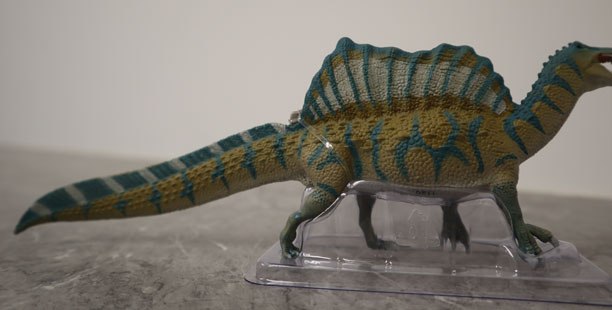Team members at Everything Dinosaur have been asked to cast their expert eyes over a display board that focusses on Spinosaurus (Spinosaurus aegyptiacus). Spinosaurus has become an increasingly popular dinosaur with children since it featured as the main protagonist in the third of the “Jurassic Park” films – “Jurassic Park III” that was released in 2001.
The public profile of this dinosaur was also boosted when it was featured in the first episode of the six-part BBC documentary series “Planet Dinosaur” that first aired ten years ago (2011).

“Spiny or Thorn Lizard”
Known from the Late Cretaceous of North Africa (Cenomanian faunal stage), Spinosaurus (S. aegyptiacus) is regarded by many palaeontologists as the largest theropod dinosaur known to science. Its exact size remains controversial with various size estimates and assessments of body mass having been made. Several studies have indicated that this carnivore could have reached lengths in excess of 15 metres and perhaps weighed as much as 20 tonnes.

Picture credit: Everything Dinosaur
The picture (above) shows the Wild Safari Prehistoric World Spinosaurus figure. The model makers depicted this dinosaur as a quadruped. They took great care to reflect the known science regarding the huge sail. The designers created the model after studying Spinosaurus fossils.
To view the Wild Safari model range: Wild Safari Prehistoric World Models.
A Dinosaur that Behaved Like a Crocodile
Much of what we know about Spinosaurus comes from research carried out over the last twenty-five years. Although it was named and scientifically described over a hundred years ago.
Spinosaurus (S. aegyptiacus), was described in 1915 by the famous German palaeontologist Ernst Stromer von Reichenbach based on fragmentary fossils found in series of expeditions to the Bahariya depression in the Western Desert of Egypt. Much of the fossil material collected during these expeditions was destroyed by allied bombing raids in World War II.
Everything Dinosaur team members have updated the information panel for the exhibition. The panel provides readers with details of some of the most recent research that suggests that Spinosaurus was quadrupedal and semi-aquatic.

The function of the enormous sail remains a mystery. This structure was formed by elongated spines that were extensions of the back vertebrae. The sail may have played a role in helping this large dinosaur keep cool (thermoregulation). It also may have played a role in visual communication between spinosaurs. The spines could even have supported a fleshy hump that stored reserves of fat. The display panel we have helped to prepare will help to tell the story of how our perceptions regarding “Spiny or Thorn Lizard” has changed over the years.
Visit the award-winning Everything Dinosaur website: Everything Dinosaur.






Leave A Comment